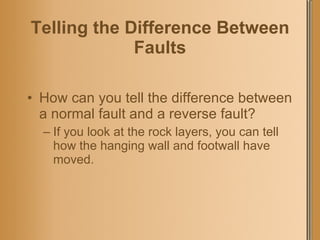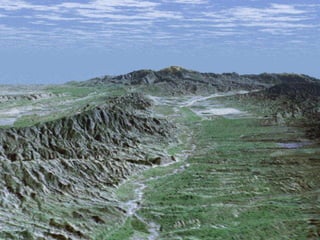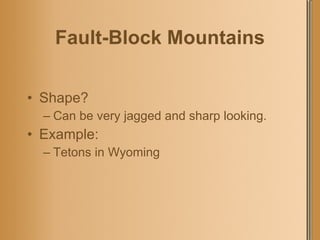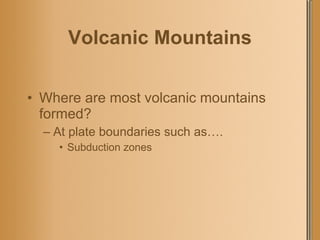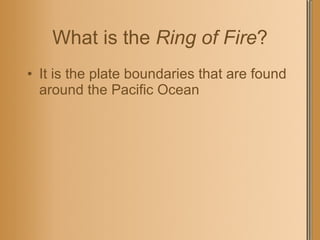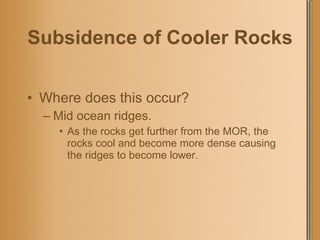4 4 Deformation
- 1. Chapter 4 Plate Tectonics 4-4 Deforming the Earth’s Crust
- 2. Essential Questions/Learning Goals: How does stress affect the Earth’s crust? Describe the three major types of folds.
- 3. Science Terms: Compression Tension Folding
- 4. Section Introduction: What is stress? The amount of force per unit of area on a substance.
- 5. Deformation What is deformation? Changes in a rock’s shape due to stress De = “undo” Form = “shape” – tion = “process of”
- 6. Compression What is compression? Stress that squeezes rocks together What kind of boundary has compression? Convergent boundaries.
- 7. Tension What is tension? Stress that stretches rocks. What kind of boundary has tension? Divergent
- 8. Folding What are folds? Bends in rocks due to stress.
- 9. Types of Folds The two most common types of folds are: Anticlines: Upward folds (arches) Synclines: Downward folds (troughs)
- 11. What is a monocline fold? A fold that has both ends of the fold still horizontal. There is a middle portion that bends downwards.
- 12. Monocline fold
- 13. How big are folds? Folds can be as large as mountains Or As small as centimeters
- 15. Faulting Essential Question: How are the three types of faults different from each other? Science Term Fault
- 16. What is a Fault? A break in rocks where one rock slide past the other
- 18. What are the pieces of broken rock on each side of the fault called? Fault blocks. Two types: Footwall Hanging wall
- 19. Footwall The block of rock beneath the fault You can climb up the footwall
- 20. Hanging Wall The block of wall above the fault. You could stand underneath a hanging wall.
- 21. Normal Faults How do the fault blocks move in a Normal Fault? The hanging wall slides down the foot wall What kind of stress makes a Normal Fault? Tension What kind of boundary are you likely to find a Normal Fault at? Divergent Boundary
- 23. Reverse Faults How do the fault blocks move in a Reverse Fault? The hanging wall slides up the footwall What kind of stress makes a Reverse Fault? Compression What kind of boundary are you likely to find a Reverse Fault at? Convergent
- 25. Telling the Difference Between Faults How can you tell the difference between a normal fault and a reverse fault? If you look at the rock layers, you can tell how the hanging wall and footwall have moved.
- 26. Strike Slip Faults How do the fault blocks move in a strike slip fault? The blocks grind and slide past each other horizontally Example of a strike slip fault San Andreas Fault
- 29. Plate Tectonics and Mountain Building What kinds of mountains are built by Plate Tectonics? Folded mountains Fault-block mountains Volcanic mountains
- 30. Folded Mountains How are these mountains formed? Plates colliding at a… Convergent boundary Examples: Appalachian, Alps, Himalayas.
- 31. Fault-Block Mountains How are these mountains formed? Tension pulling huge blocks of rocks apart. Gravity causes the hanging wall to slide down the footwall Normal faulting
- 32. Fault-Block Mountains Shape? Can be very jagged and sharp looking. Example: Tetons in Wyoming
- 33. Volcanic Mountains How are these mountains formed? When plates collide and one is… Subducted The melted crust rises to form volcanic mountains
- 34. Volcanic Mountains Where are most volcanic mountains formed? At plate boundaries such as…. Subduction zones
- 36. What is the Ring of Fire ? It is the plate boundaries that are found around the Pacific Ocean
- 39. Uplift and Subsidence What type of motion occurs in the crust in uplift and subsidence? Vertical movement Uplift? Upward movement of blocks of rock May or may not be deformed by stress Subsidence? Downward movement of blocks of rock Usually are not deformed by stress.
- 40. Uplifting of Depressed Rocks Rocks that have been pushed down by the weight of glaciers will rise upwards after the glacier has melted away. This is called… Rebound Does deformation occur? No.
- 42. Subsidence of Cooler Rocks As rocks cool, they take up less… Space or volume What does this mean for the height of mountains? They shrink!
- 43. Subsidence of Cooler Rocks Where does this occur? Mid ocean ridges. As the rocks get further from the MOR, the rocks cool and become more dense causing the ridges to become lower.
- 44. Tectonic Letdown What happens to the crust when you stretch it? It will sink lower This creates a… Rift zone
- 45. Tectonic Letdown What kind of boundary does this occur at? A divergent boundary What kind of fault occurs here? Normal faults.
























